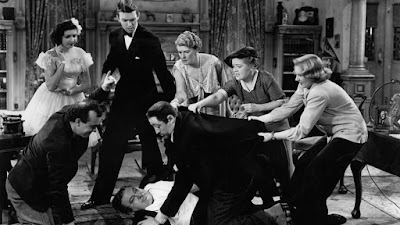De acordo com o Livro Guinness dos
Recordes, Sherlock Holmes é “o personagem literário humano com mais aparições
no cinema e na TV”. Em 2012, quando ele foi reconhecido pelo Guinness, havia
254 filmes e séries envolvendo Sherlock, e isso inclui tanto as adaptações
diretas do trabalho de Conan Doyle quanto paródias. Um dos atores mais
inesquecíveis a interpretar Holmes foi Basil Rathbone, que encarnou o detetive
em 14 filmes, começando em 1939, quando “O Cão dos Baskervilles” e “Sherlock
Holmes” estrearam.
According to the Guinness Book, Sherlock
Holmes is “the most portrayed literary human character in film & TV”. In
2012, when he was awarded by the Guinness, there had been 254 films and TV
shows involving Holmes, no matter if they were direct adaptations of Conan
Doyle's work or parodies. One of the most unforgettable actors to portray
Holmes was Basil Rathbone, who played the detective 14 times, beginning
with in 1939, when both “The Hound of
the Baskervilles” and “The Adventures of Sherlock Holmes” were released.
Descrito como “uma incursão no
terror”, “O Cão dos Baskervilles” traz Sherlock (Rathbone) e o doutor Watson
(Nigel Bruce) ao encontro do Sir Henry Baskerville (Richard Greene), um
herdeiro que está prestes a se mudar para uma mansão em Devonshire após a morte
do antigo proprietário. Dr Mortimer (Lionel Atwill) tem certeza de que o tal
antigo proprietário, Sir Charles, foi assassinado por um cão colossal, por isso
ele contratou Sherlock. Esta primeira aventura foi um grande sucesso, e o
segundo filme da dupla chegou aos cinemas em menos de seis meses.
Described as “an incursion in terror”,
“The Hound of the Baskervilles” brings Sherlock (Rathbone) and Doctor Watson
(Nigel Bruce) to meet Sir Henry Baskerville (Richard Greene), a heir who is
about to move to a mansion in Devonshire after the previous owner was found
dead. Dr. Mortimer (Lionel Atwill) is certain that the former owner, Sir
Charles, was murdered by a canine beast, that's why he hired Holmes. This first
adventure was so successful that the second film of the duo hit the theaters
within six months.
Em “Sherlock Holmes”, o nefário
Professor Moriarty (George Zucco) acaba de ser absolvido em um julgamento. Seu
inimigo, Sherlock Holmes (Rathbone) chega tarde ao tribunal com algumas novas
provas, mas Moriarty já está livre. Holmes e Moriarty conversam amigavelmente e
dividem uma carruagem ao sair do prédio, mas prometem ficar de olho um no
outro. Em casa, Moriarty cuida de suas flores e arquiteta um novo plano
infalível para cometer o crime do século.
In “The Adventures of Sherlock Holmes”, the nefarious Professor Moriarty (George Zucco) has
just been found not guilty of a few crimes. His nemesis, Sherlock Holmes
(Rathbone) arrives late at the court with some new evidence, but Moriarty is
already free. Holmes and Moriarty amiably chat and share a carriage as they
leave the building, but they promise to keep an eye on each other. At home,
Moriarty takes care of his flowers and plots a new infallible plan to commit
the crime of the century.
Em casa, Sherlock recebe uma carta e
mais tarde a visita de Ann Brandon (Ida Lupino), que acredita que seu irmão
recebeu uma ameaça de morte através de um desenho enigmático. Quando Ann e
Sherlock estão conversando, Jerrold Hunter (Alan Marshal), noivo e advogado de
Ann, chega para dizer que ela está exagerando. Holmes decide investigar o caso mesmo
assim – exatamente como Moriarty imaginou que ele faria. Enquanto Sherlock se
disfarça para proteger Ann, Watson se torna guardião das joias da Coroa.
At home, Sherlock receives a letter and later the visit of Ann Brandon (Ida Lupino), who believes her brother received a death threat through an enigmatic drawing. When Ann and Sherlock are talking, Jerrold Hunter (Alan Marshal), Ann’s fiancé and solicitor, arrives to say she’s overreacting. Holmes decides to take the case anyway – just like Moriarty imagined he’d do. While Holmes even disguises himself in order to protect Ann, Watson becomes a guardian of the Crown Jewels.
Essa história parece um pouco familiar? Ela já havia sido filmada antes: em 1916, com William Gillette, que escreveu a peça “Sherlock Holmes” baseado nas obras de Conan Doyle, e em 1922, com John Barrymore como Sherlock. Bem, não foi esta história em particular que já havia sido filmada antes: o filme de 1939 faz algumas modificações, como a adição dos personagens Ann Brandon e Jerrold Hunter, e também a trama com as joias da Coroa.
Does this story sound a bit familiar? It had already been filmed before: in 1916, with William Gillette, who wrote the play “Sherlock Holmes” based on Conan Doyle’s works, and in 1922, with John Barrymore as Holmes. Well, it wasn’t this story in particular that was filmed before: the 1939 movie makes a few changes, like adding the characters Ann Brandon and Jerrold Hunter, and also the plot involving the Crown Jewels.
Nestes dois filmes, Watson serve mais como alívio cômico, sendo um homem simplório sempre pasmo com as deduções de Sherlock – e, em “Sherlock Holmes”, ele inclusive tem ciúmes de um garoto esperto, Billy (Terry Kilburn). Watson já foi de tudo no cânone de Sherlock: originalmente o narrador das aventuras, ele já foi o melhor amigo, o ajudante, o alívio cômico e até o interesse amoroso. Se você viu a série Sherlock da BBC, você sabe que até a senhora Hudson insinua que Sherlock e Watson são um casal.
In these two films, Watson is more like
comic relief, being a silly man always baffled by Sherlock's deductions – and,
in “The Adventures of Sherlock Holmes”, even jealous of a clever child, Billy
(Terry Kilburn). Watson has been all kinds of things in the Sherlock canon:
originally the narrator of the adventures, he has been the best friend, the
sidekick, the comic relief and even the romantic interest. If you have seen the
BBC series Sherlock, you know even Mrs Hudson insinuates that Sherlock and
Watson are a couple.
Estes dois filmes de Sherlock de
1939 foram produzidos por Darryl Zanuck na 20th Century Fox e têm
cerca de 80 minutos de duração cada um. Ambas as histórias se passam no final
do século XIX, quando Conan Doyle escreveu suas obras, e ambos os filmes têm um
design de produção incrível. Entretanto, havia um problema: estes filmes eram
caros demais! Por isso a Fox dispensou Holmes e Watson e os outros 12 filmes
com Rathbone e Bruce interpretando os personagens foram produzidos pela
Universal e ambientados nos tempos modernos.
These two Sherlock films from 1939 were
produced by Darryl Zanuck at 20th Century Fox and run at about 80
minutes each. Both stories are set in the late 19th century, when
Conan Doyle wrote the stories, and both movies have great production design.
However, there was a problem: those films were too expensive! That's why Fox
ditched Holmes and Watson and the other 12 films with Rathbone and Bruce
playing the characters were produced at Universal and set in modern times.
“Sherlock Holmes” não foi o
primeiro filme a usar a frase “Elementar, meu caro Watson” – “A Volta de
Sherlock Holmes” de 1929 foi o primeiro – mas foi este filme que popularizou a
frase. Ao contrário do que muitos acreditam, a frase não existe em nenhuma
história de Conan Doyle: é uma invenção do cinema.
“The Adventures of Sherlock Holmes” was
not the first film to use the quote “Elementary, my dear Watson” – “The Return
of Sherlock Holmes” from 1929 introduced it – but it was the movie that made
the quote popular. Contrary to popular belief, the quote can’t be found in
Conan Doyle’s work: it is a purely cinematic invention.
Basil Rathbone não encabeçava
sequer os créditos em “O Cão dos Baskervilles” – o nome de Richard Greene
aparecia primeiro porque era uma estrela mais conhecida em 1939. Até Nigel
Bruce tinha mais tempo em cena do que Rathbone no primeiro filme! Mas Basil
Rathbone, com charme, sabedoria, um violino, um cachimbo e um robe – que foram
abandonados nos filmes feitos na Universal – deixou sua marca como Sherlock
Holmes, e sempre será lembrado como um dos atores que melhor personificou o
famoso detetive.
Basil Rathbone wasn’t even first billed in “The Hound of the Baskervilles” – Richard Greene was, because he was a more established star in 1939. Even Nigel Bruce had more screen time than Rathbone in the first film! But Basil Rathbone, with charm, wittiness, a fiddle, a pipe and a robe – that were abandoned in the movies made by Universal – left his mark as Sherlock Holmes, and will be forever remembered for being one of the actors who perfectly embodied the famous detective.
This is my contribution to The Suave Swordsman: Basil Rathbone blogathon, hosted by Gabriela at Pale Writer.



































